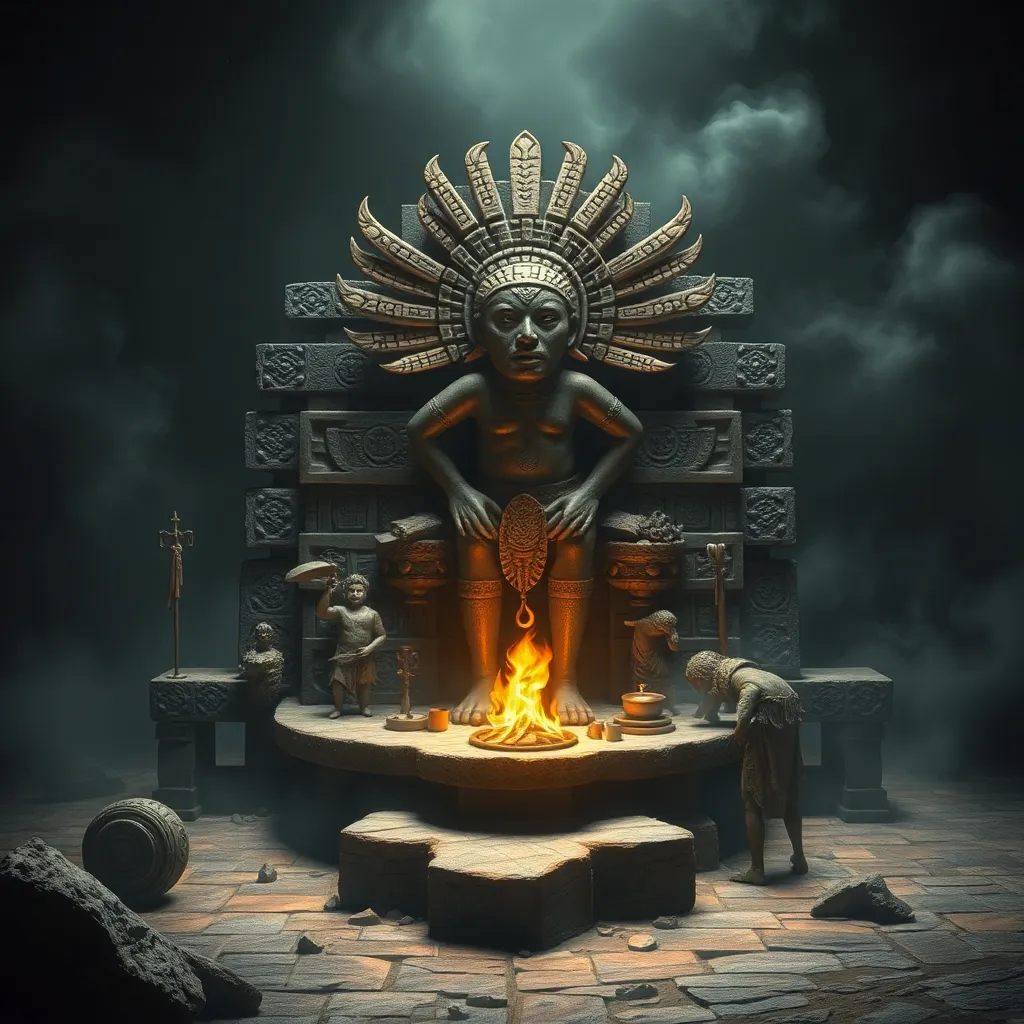Cipactli’s Sacrifice: A Foundation for Life and Order in Aztec Myth
I. Introduction
Aztec mythology is a rich tapestry of deities, creation stories, and cosmological principles that reflect the values and beliefs of the Aztec civilization. At the center of this mythology is Cipactli, a primordial deity often depicted as a monstrous crocodile or Earth monster. This article explores the significance of Cipactli’s sacrifice, which serves as a foundational myth for life, order, and creation in Aztec cosmology.
II. The Myth of Cipactli
A. Cipactli’s origin and depiction
Cipactli is known as one of the first beings to inhabit the cosmos, emerging from the primordial chaos. Described as a fearsome creature, Cipactli’s form is often represented as a crocodile or a monstrous fish, embodying both the earth and the sea. In some narratives, it is said that Cipactli had a body covered in teeth and could devour anything in its path.
B. The role of Cipactli in the creation of the world
According to Aztec mythology, Cipactli played a crucial role in the creation of the world. In the beginning, there was only darkness and chaos, and Cipactli existed as a part of this void. The gods, seeking to create order from chaos, aimed to harness Cipactli’s power to bring forth the world.
C. The narrative of Cipactli’s sacrifice
The story of Cipactli’s sacrifice is both dramatic and pivotal. The gods, realizing they needed to subdue Cipactli to create the earth, devised a plan to kill the creature. After a fierce battle, they succeeded in defeating Cipactli. The gods then dismembered the body of Cipactli, using its flesh and bones to shape the world. This act of sacrifice was not merely about destruction; it was an essential step in the creation of the universe.
III. The Symbolism of Sacrifice in Aztec Culture
A. The meaning of sacrifice in Aztec religion
In Aztec religion, sacrifice was a sacred act that held profound significance. It was believed that through sacrifice, the gods could be honored and appeased, ensuring the continuation of life and balance in the cosmos. The act of giving up something valuable was seen as a necessity for the sustenance of the world.
B. Connection between sacrifice and the cyclical nature of life
The Aztecs understood life as cyclical, with death and rebirth occurring in a continuous cycle. Sacrifice was integral to this understanding, representing the need for renewal. Cipactli’s sacrifice was emblematic of this cycle, suggesting that out of death comes new life.
C. Cipactli’s sacrifice as a metaphor for renewal and creation
Cipactli’s sacrifice serves as a powerful metaphor for renewal and creation. Just as the earth was formed from the remains of Cipactli, so too do the cycles of life and death foster regeneration. The myth encapsulates the belief that sacrifice is necessary for growth and transformation.
IV. Cipactli’s Role in the Creation of Humanity
A. The transformation of Cipactli’s body into the earth
As Cipactli’s body was dismembered, various parts became integral elements of the earth: mountains, valleys, rivers, and plains. This transformation signifies that humanity and the world itself are intrinsically linked to Cipactli’s essence, highlighting the interconnectedness of all life.
B. How Cipactli’s sacrifice contributed to the birth of humanity
Following the creation of the earth, the gods created humanity from the remnants of Cipactli. This act reinforces the belief that humans share a connection with the divine and the primordial being. In essence, humanity is seen as both a product and a continuation of Cipactli’s sacrifice.
C. The relationship between gods and mortals in this context
The narrative of Cipactli’s sacrifice illustrates the complex relationship between gods and mortals. Humans are not merely subjects of the gods; they are a vital part of the cosmic order established by divine actions. This relationship emphasizes the importance of maintaining balance and harmony within the world.
V. The Importance of Order and Balance
A. The concept of Teotl and the balance of forces
In Aztec thought, Teotl represents the fundamental force of life and the cosmos. It embodies both creation and destruction, emphasizing the duality inherent in existence. Cipactli’s sacrifice is a key event in the establishment of order among these forces.
B. How Cipactli’s sacrifice established order in the cosmos
By sacrificing Cipactli, the gods were able to impose order on the chaotic universe. This act of creation not only formed the physical world but also established a cosmic balance that was crucial for the continuation of life. The myth underscores the belief that chaos must be confronted to achieve harmony.
C. The implications of chaos and order in Aztec belief
Chaos and order are central themes in Aztec belief systems. The myth of Cipactli serves as a reminder that chaos is ever-present, but through sacrifice and divine intervention, order can be restored. This understanding shaped the Aztecs’ worldview and their practices in life.
VI. Cultural Reflections and Rituals
A. How Cipactli’s story influenced Aztec rituals
The story of Cipactli had a profound influence on Aztec rituals and ceremonies. The themes of sacrifice, renewal, and the cyclical nature of life were embedded in various religious practices. Rituals often included offerings and sacrifices to the gods, reflecting the ongoing need to honor the divine.
B. Festivals and practices commemorating the deity
Certain festivals were dedicated to honor Cipactli and the creation myths associated with it. These celebrations often included:
- Ritual dances
- Offerings of food and flowers
- Symbolic sacrifices to ensure agricultural fertility
C. The role of sacrifice in maintaining societal order
In Aztec society, sacrifice was seen as a means to maintain order and societal harmony. By performing sacrifices, the Aztecs believed they were fulfilling their obligations to the gods and ensuring that the balance of the cosmos remained intact.
VII. Modern Interpretations and Legacy
A. The relevance of Cipactli’s sacrifice in contemporary discussions
The myth of Cipactli continues to resonate in modern discussions about sacrifice, ecology, and the interconnectedness of life. It serves as a reminder of the importance of respecting the natural world and recognizing the cycles of life.
B. How modern interpretations reflect ancient beliefs
In contemporary culture, Cipactli’s story has inspired various interpretations that reflect ancient beliefs about sacrifice and renewal. Artists, writers, and scholars draw upon the themes of the myth to explore issues related to environmentalism, spirituality, and cultural identity.
C. The impact of Cipactli’s myth on art and literature
Cipactli’s myth has influenced various forms of artistic expression, including:
- Visual arts that depict creation themes
- Literature that explores the interplay of chaos and order
- Performative arts that commemorate Aztec heritage
VIII. Conclusion
In summary, Cipactli’s significance in Aztec mythology is profound, serving as a foundational narrative that illustrates the importance of sacrifice in shaping life and order. The story of Cipactli not only reflects the ancient beliefs of the Aztec civilization but also provides enduring insights into the cyclical nature of existence and the interconnectedness of all beings. Understanding these cultural myths enriches our appreciation of the diversity of human experience and the values that continue to influence societies today.



